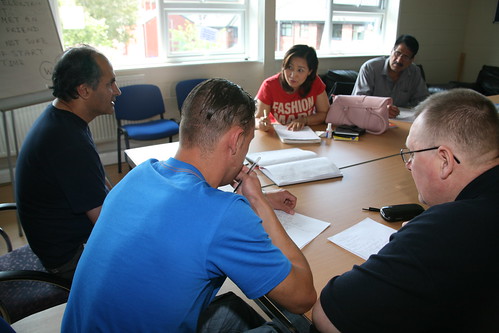Well done, Roberto. A very good piece of work, but next time don't forget to use more adjectives!
This is not very useful. The student is likely to read the comment and instantly forget about it and wonder why they put all that effort into writing their piece in the first place.
To combat this vagueness, popular advice to teachers in recent years has focused on getting students to think about their own errors, for example by the teacher underlining them and asking the student to go away and work them out and re-correct them. The problem with this is that it is highly time-consuming and very difficult for the student (if they knew their mistakes perhaps they wouldn't have made them in the first place). Some teachers use a complicated set of abbreviations in order to point the student to what kind of error they made,
sp. = spelling error
lc = use lower case
cap. = use capital letter
v. = wrong verb
adv. = wrong adverb
? = I don't understand
............ and so on. The trouble with this is that you would have to do a lesson or two teaching them what all the symbols meant. More importantly, how can you guarantee that the learners would actually bother to look at these pointers and correct the work? Maybe a few conscientious ones will re-draft at home and hand it in again the following week, but the majority will probably file it away and forget about it.
Imagine if we corrected speaking this way (!), shouting out "VERB!" and "PRONUNCIATION!" as the poor student tried to articulate what he was trying to say. The quickest way of correcting a speaking error is on the spot, by reformulating what the student said. A rather crude example:
- Student: I go London last week
- Teacher : You went to London last week?
- Student: Yes, I went to London last week and....
The hope is that over time, and once the same errors have been corrected multiple times, the student will eventually assimilate the correct usage. There is no reason why this approach cannot be used for writing skills too. Myers (1997) in an article for TESL-EJ, detailed how she used reformulation to correct and improve students' sentence-level syntax. The student writes a first draft, the teacher corrects all the errors (spelling, grammar etc.) and in addition suggests more 'natural' alternatives. The student then looks at the corrected draft and re-writes it without the original errors, producing what Myers calls a "clean copy." Myers then distributed the clean copies amongst the class so they could read each other's work without being impeded by errors, grammatical or otherwise.
Myers used this technique with ESL students in the US studying at university level. I argue that this technique can be used at any level and for whatever kind of written text. I have produced some notes explaining the basics:
Reformulation for ESL Writing: A Guide
The advantages:
- Although the text is corrected by the teacher, the 'voice' and meaning remain the student's.
- The student receives feedback that is 100% individualised. No-one in the class is left out.
- It can be instantaneous, in the same class period (no waiting for the next class for feedback).
Further reading:
Reformulation Revisited (Kusuyama, 2003)

